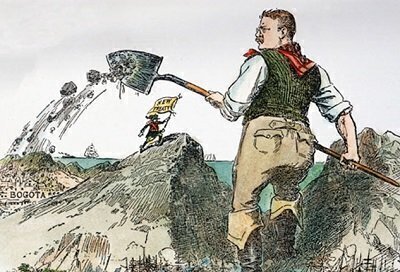On December 31, 1999, the United States officially handed the Panama Canal over to Panama’s government, ending a long saga that had started a century and a half earlier.
American dominance over the Canal started to wane in 1978, when the United States and Panama approved the Torrijos-Carter Treaties. The Panama treaty talks were initiated in the Nixon administration and supported by President Gerald Ford. Jimmy Carter changed his public stance against the treaties after becoming President, leading efforts to gain Senate approval in 1978.
The treaties specified that the Canal would be turned over to Panama on December 31, 1999, but the United States had the right to defend the Canal’s neutrality, if needed.
Plans for a trans-Isthmus canal had their roots in the 1850s, when the U.S. and Great Britain negotiated the Clayton-Bulwer Treaty for a canal through Nicaragua. French attempts to build a canal failed in the 1880s, with an estimated 20,000 lives lost in the effort.
The United States effort started in 1901, when Theodore Roosevelt assumed office and made the canal a top priority for his administration.
“The Panama Canal would not have been started if I had not taken hold of it, because if I had followed the traditional or conservative method I should have submitted an admirable state paper occupying a couple of hundred pages detailing all of the facts to Congress and asking Congress’ consideration of it,” Roosevelt told an audience in 1911.
“In that case there would have been a number of excellent speeches made on the subject in Congress; the debate would be proceeding at this moment with great spirit and the beginning of work on the canal would be 50 years in the future. Fortunately the crisis came at a period when I could act unhampered. Accordingly, I took the Isthmus, started the canal and then left Congress not to debate the canal, but to debate me.”
In his first State of the Union address in 1902, President Roosevelt made it clear that the canal was a top priority for his administration.
“No single great material work which remains to be undertaken on this continent is of such consequence to the American people as the building of a canal across the Isthmus connecting North and South America,” he told Congress. “It is emphatically a work which it is for the interest of the entire country to begin and complete as soon as possible; it is one of those great works which only a great nation can undertake with prospects of success, and which when done are not only permanent assets in the nation’s material interests, but standing monuments to its constructive ability.”
In 1903, the United States supported a bloodless revolution in the Colombian province of Panama after the Colombian government rejected a U.S. treaty to acquire land in Panama to build the canal. The United States Senate offered $10 million for the land; the Colombian government wanted $25 million.
As the Colombian government sent troops to put down the rebellion, a U.S. warship, the Nashville, appeared with a contingent of Marines off the Panamanian coast, along with other U.S. naval vessels. The next day, Panama declared independence and Roosevelt quickly recognized Panama as a Republic and offered it protection.
Philippe Bunau-Varilla, a French citizen, acted as Panama’s agent and negotiated a new canal treaty with Secretary of State John Hay, which was ratified by the Senate in February 1904. The United States government gave the $10 million offered to Colombia to the Panamanians as part of a new treaty. It also supplied a constitution to Panama that gave the American government the right to “intervene in any part of Panama, to reestablish public peace and constitutional order.”
The President’s actions didn’t go unopposed back home, with some calling it “an act of sordid conquest.” But that didn’t stop the United States from starting its Panama Canal project that year. The 10-year project cost $375 million and 5,609 lives, and to many it became the new symbol of American imperial power.
On August 15, 1914, the Panama Canal officially opened for business, during the administration of President Woodrow Wilson.








